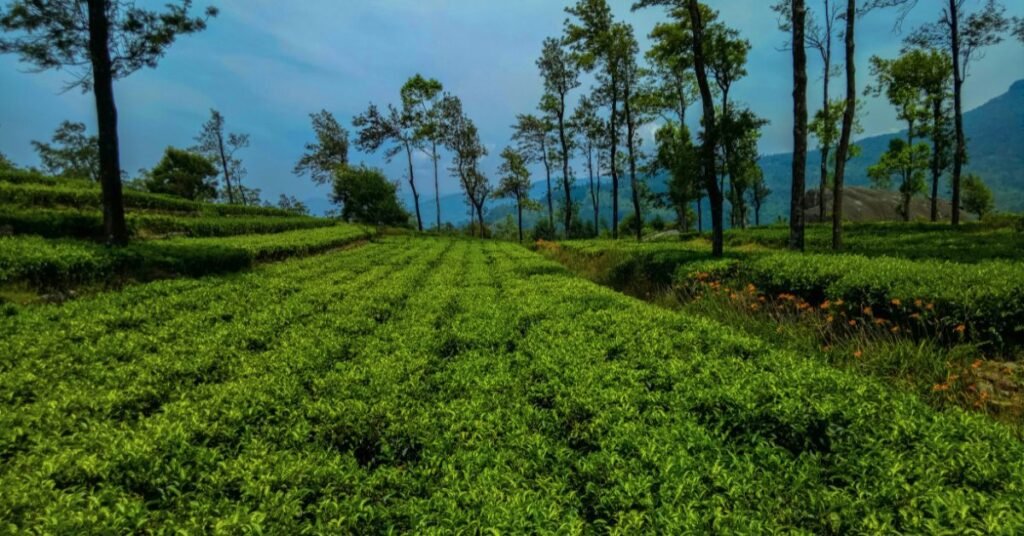The Tea Estates of Assam are a living heritage, producing teas that are famous all around the globe. From the rich soils of the Brahmaputra valley to the “two leaves and a bud” plucking process, with each cup is a story of ecological impacts, colonial architecture, traditional production methods, and tribal customs. Today, innovative tea tourism through Assam’s hills and valleys present everlasting experiences, and institutes such as Tocklai conduct research for climate resilience to safeguard the future of Assam’s golden leaf.
Geological Advantages of the Land
Assam’s fertile plains result from the rich alluvial deposits of the Brahmaputra—full of nitrogen and phosphorus—giving way to the “perfect storm” of temperatures of 20–30 °C and over 2,500 mm of rainfall annually. Wild tea was consumed locally by the tribes in herbal decoction long prior to commercial plantations in the 1830s. This shows us the ancient tea heritage of Assam.

Botanical Anomaly of Assamese Tea
A departure from Camellia sinensis var. sinensis’s diminutive-leafed variety, however, is Camellia sinensis var. assamica of indigenous origin in Assam, which grows into trees to 20 m if left untrimmed, providing polyphenol- and amino acid-richer leaves that account for the bold, malty character of Assam tea.
Colonial Chang Bungalows of the Tea Estates
Tea plantations include “chang bungalows” with flood-proof raised foundations and air circulation, monsoon-friendly wide verandahs, mud-and-bamboo walls to repel cold, and spy rooms from the independence era of India.
Hidden Language of Tea Estates of Assam
Labour is organized under the kamjari system—using whistles, drums and flags to coordinate pickers across vast fields where speech cannot reach. While most estates pluck “two leaves and a bud,” top estates adopt P+1 (just one leaf plus bud) for ultra-refined teas—pickers develop “picker’s thumb” calluses for precision.
Ecological Sanctuaries within Plantations
Many tea estates of Assam double as wildlife corridors—Mancotta Estate hosts a private hoolock gibbon conservation area since 1978, while Hatikhuli Estate helps maintain elephant pathways between Kaziranga and Karbi Anglong hills.
Culture of the Tea Tribes
“Tea Tribes” descend from 19th-century Central Indian labourers. Their Jhumur dance blends tribal rhythms with plucking gestures, and Bagan Puja honors garden spirits. Dialects like Sadri-Bagania fuse tribal and Assamese lexicons.

Culinary Traditions: Jolpan and Pitha
Workers’ “bagan rations” evolved into:
- Hutch curry: Slow-cooked in bamboo for 8–10 h
- Pani Pitha: Rice-flour pancakes often dipped in green chutney.
- Til Pitha (Sesame Laru): Glutinous-rice rolls stuffed with sesame and jagger.
Modern Tea Tourism & Taxi Nation
Tea tourism now sustains estates and communities—visitor inflows can exceed 9 million annually, boosting worker retention by 30–40% and premium tea pricing by 15–25%. Taxi Nation, a car rental service across Northeast India, offers safe, comfortable access to remote estates, from dawn plucking demos to sunset cupping workshops.
Experiences Beyond the Ordinary
– Midnight Withering at Mancotta: Witness leaf dehydration under starlight
– Tea Archaeology at Wild Mahseer: Explore 1850s machinery
– Cultivar Museum at Gatoonga: See 150 + wild strains
– Cupping Labs at Sangsua: Learn pro cupping techniques
Future Horizons
As modern tea tourism surges, Assam’s domestic tourist arrivals soared by 573% and foreign visitors by 783% in 2023 alone—estates are diversifying into immersive experiences. This wave of experiential travel not only boosts local economies—raising worker retention by up to 40% and premium tea pricing by as much as 25% —but also channels revenue into conservation.
The Tea Research Association’s Tocklai Centre in Jorhat safeguards over 3,000 genetic accessions and pioneers climate-resilient varieties poised to withstand erratic monsoons and rising temperatures. Meanwhile, seamless logistics remain critical to unlocking Assam’s hidden gems—Taxi Nation, headquartered in Guwahati with over two decades of regional expertise, offers reliable inter- and intra-state car rentals across Guwahati, Kaziranga, Shillong and beyond.
What makes Assam tea so distinctive?
Assam tea’s bold, malty flavor comes from its indigenous Camellia sinensis var. assamica, the region’s nutrient-rich alluvial soils, and precise “two leaves and a bud” (or ultra-refined “P+1”) plucking standards.
When is the prized first‐flush harvest?
The first flush occurs from late February to early April, yielding delicate floral notes and commanding auction prices upwards of ₹75,000 per kilogram.
Who are the “Tea Tribes” of Assam?
Descendants of 19th-century Central Indian labourers, the Tea Tribes developed a syncretic culture—Jhumur dance, Bagan Puja rituals and occupational creoles (Sadri-Bagania)—that blends tribal traditions with Assamese influences.
How do tea estates support wildlife?
Many estates double as ecological corridors, with the Mancotta Estate hosting a private hoolock gibbon reserve since 1978 and Hatikhuli Estate integrating elephant pathways between Kaziranga and adjacent forest fragments.
How can I visit remote estates?
For tailored transport across Assam’s tea regions—from dawn plucking demos to heritage bungalow stays—Taxi Nation provides vetted drivers and a fleet of sedans, SUVs and luxury vehicles, serving Guwahati, Kaziranga, Shillong and beyond.




